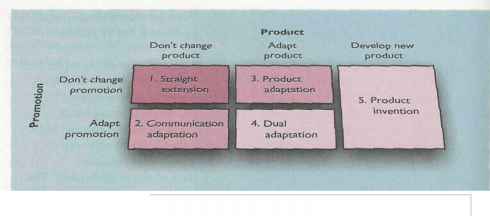Standardization or Adaptation for International Markets
Atone extreme are companies that use a standardized marketing mix worldwide. Proponents highlight several reasons for global standardization.
standardized marketing mix
An international marketing strategy for using basically the same product, advertising, distribution channels and other elements of the marketing mix in all the company's iniernacujnal markets.
Tins Italian execution of a Pirelli campaign allows the global application of many of today's ads.

HOMOGENEOUS NEEDS AND PREFERENCES. The presence of homogeneous needs among customers permits the building of global brands such as Levi jeans and Nike sports shoes. In these cases, the 'home culture' has been successfully exported to mass markets abroad, where consumers share a similar attraction to the cult image that Levi portrays and the 'just do it' attitude that Nike extols. The success of Ilaagcn-Dazs is another case in point. The product has a long history in North America. Under a new, aggressive management team, it was successfully launched in Japan and Europe. Throughout these markets, Haagen-Dazs uses a standard marketing approach: high quality, high price, selective distribution outlets and sexual imagery. Similar examples can be found for niche products, especially luxury goods: Carder jewellery, Roles watches, Royal Doulton fine china, Mikimoto pearls and Louis Vuitton luggage are all marketed in the same way to consumers showing similar preferences for the exclusive image that these brands portray across the globe.
CONSUMER MOBILITY- A larger number of people are travelling more widely, thus allowing more products to be marketed to them on a global basis. Kodak film, for example, is sold worldwide in its distinctive yellow box and the emphasis upon wide availability is similar across markets. Travellers can expect to find Novotel hotels across Europe to offer similar standards of service and food.
ECONOMIES OP SCALE/EXPERIENCE. In many industries, cost advantages are essential for competitive success when operating on a global scale. Economies are derived from discounts from bulk purchases and/or sharing R & D, marketing, production and managerial resources among different markets. A
standardized marketing programme reduces costs even further, letting companies offer consumers higher-quality and more reliable products at lower prices.
Gillette Sensor's worldwide launch is a good case of how the firm derived scale economies from a standardized global approach. The Sensor took ten years to develop. It represented a breakthrough in wet-shave technology. It was essentially a niche product. To recuperate funds already spent on the product's development and launch, it needed high unit sales, so had to be marketed globally. Gillette identified three cultural universals (attributes that transcend national cultures) associated with wet shaving: comfort, closeness of shave and safety. The company exploited these; in a common communications campaign — 'the best a man can get'. The worldwide launch was a phenomenal success. So successful was the Sensor campaign that its effects spilled over into a new, complementary product - the Shaving Gel - which enjoyed raised awareness and sales!
TECHNOLOGICAL FEASIBILITY. In product sectors where the technological processes are homogeneous, standardization becomes a prerequisite for market success. For simple technologies like the production of mouldings, toys, paint, hand tools and so forth, it makes sense to standardize the product as much as possible to keep costs down. This is also the thinking behind Coca-Cola's decision that Coke should taste about the same around the world and Ford's production of a 'world car' that suits the needs of most consumers in most countries. At the other extreme is an adapted marketing mix. In this case, the producer adjusts the marketing mix elements to each target, bearing more costs but hoping for a larger market share and return. Nestle, for example, varies its product line and its advertising in different countries. The rationale for marketing mix adaptation is the reverse of the reasons given for standardization. Most important are the disparities among different country markets.
DIVERSITY. Proponents of adaptation argue that consumers in different countries vary greatly in their geographic, demographic, cconomic'and cultural characteristics. Differences in the following factors suggest the need to adapt the firm's product offering for international markets: product preferences; uses and conditions of product use; customer needs, perceptions and attitudes; consumers' shopping patterns; income levels and spending power; the country's laws and regulations; user/customer skills or education; competitive conditions; advertising laws; and media availability. In the single European market, many argue that the 'Euroconsumer' is a myth. Marketers are advised to identify carefully differences that do exist across national markets and tailor products and services to suit local tastes and preferences. The dictum 'different strokes for different folks' is still very much the way of business in international marketing.
The decision about which aspects of the marketing mix to standardize and which to adapt should be taken on the basis of target market conditions. Firms are often unwilling to modify their product offering for foreign markets because of 'cultural arrogance'. German and American machine-tool manufacturers, for example, saw their world market shares dive over the 1980s due, in part, to their reluctance to adapt products and marketing approaches in the face of changing customer needs in their home and foreign markets. 'What's good for Germany is good enough for the world market' was the view typifying a large proportion of German machinetool producers which formed the focus of a study into international marketing strategies in the UK market. This cultural arrogance has been termed the 'self-
adapted marketing niix An international marketing strategy for adjusting the marketing mix elements to each international target market, hearing more costs but hoping for a larger market, share and return.
cultunil universals Cultural characteristics and attributes found across a wide range of cultures: that is, features which transcend national cultures.

- Figure 5.3
Five international product and promotion strategies reference criterion' and has been a significant factor in accounting for poor export performance.17
The question of whether to adapt or standardize the marketing mix has been much debated in reeent years. However, global standardization is not an all-or-nothing proposition, but rather a matter of degree. Companies should look for more stan dardization to help keep down costs and prices and to build greater global brand power. But they must not replace long-run marketing thinking with short-run financial thinking. Although standardization saves money, marketers must make certain that they offer what consumers in each country want.18
Many possibilities exist between the extremes of standardisation and complete adaptation. For example, Coca-Cola sells virtually the same Coke beverage worldwide, and it pulls advertisements for specific markets from a common pool of ads designed to have cross-cultural appeal. However, the company sells a variety of beverages created specifically for the taste buds of local markets, with prices and distribution channels varying widely from market to market.
Let us now examine marketing mix decisions with regard to global marketing planning.
Straight product extension
Marketing a product in a foreign market without any change, product adaptation
Adapting a product Co meet local conditions or wants in foreign markets.
Product
Five strategics allow for adapting product and promotion to a foreign market (see Figure 5.3).w We first discuss the three product strategies and then turn to the two promotion strategies.
Straight product extension means marketing a product in a foreign market without any change. Straight extension has been successful in some cases. CocaCola, Kellogg cereals, Heineken beer and Black & Decker tools are all sold successfully in about the same form around the world. Straight extension is tempting because it involves no additional product-development costs, manufacturing changes or new promotion. But it ean be costly in the long run if products fail to satisfy foreign consumers.
Product adaptation involves changing the product to meet local conditions or wants. For example, Philips began to make a profit in Japan only after it reduced the size of its coffee makers to fit into smaller Japanese kitchens and its shavers to fit smaller Japanese hands. The Japanese construction machinery maker, Komatsu, had to alter the design of the door handles of earth movers sold in Finland: drivers wearing thick gloves in winter found it impossible to grasp the door handles, which were too small (obviously designed to fit the fingers of the average Japanese, but not the double-el added ones of larger European users!). Campbell serves up soups that match unique tastes of consumers in different countries. For example, it sells duck-gizzard soup in the Guangdong Province of China; in Poland, it features flaki, a peppery tripe soup. And IBM adapts its worldwide produet line to meet local needs. For example, IBM must make dozens of different keyboards - 20 for Europe alone - to match different languages. Marie Claire, the glossy women's magazine with a social conscience, launched its Russian edition on 1 March 1997. Marie Claire now has editions in 27 countries from South Korea to Turkey, providing a turnover for the group in 1995, the last available figure, of Ftr8S4 million (US&156m). The key to Marie Claire's success has been its ability to adapt its editorial content to the country in which it appears. In the ease of the Russian market, it acknowledges that it is a country where people still read a lot, so it is important to have long articles. As well as local stories, the magazine sticks to the usual Marie Claire formula with articles taken from other editions. The fashion pages, however, use local models and clothes, and the cover girl in the first Russian edition, for example, is Russia's top model.2"
Product invention consists of creating something new for the foreign market. This strategy can take two forms, it might mean re Intro due ing earlier product forms that happen to be well adapted to the needs of a given country. For example, the National Gash Register Company rcintroduced its crank-operated cash register at half the price of a modern cash register and sold large numbers in the Orient, Latin America, and Spain, Or a company might create a new product 10 meet a need in another eountry. For example, an enormous need exists for low-cost, high-protein foods in less developed countries. Companies such as Quaker Oats, Swift and Monsanto are researching the nutrition needs of these countries, creating new foods, and developing advertising campaigns to gain product trial and acceptance. Produet invention can be costly, but the pay-offs are worthwhile.
product invention Creating new products or services for foreign markets.
Continue reading here: Procter Gamble Going Global in Cosmetics
Was this article helpful?
Readers' Questions
-
TOM KLUG1 year ago
- Reply
-
melissa diggle1 year ago
- Reply
-
karen1 year ago
- Reply
-
emmanuel1 year ago
- Reply
-
alfonsina panicucci1 year ago
- Reply
-
SARADOC1 year ago
- Reply
-
riccardo1 year ago
- Reply
-
juhani1 year ago
- Reply
-
Cynthia1 year ago
- Reply
-
liisi1 year ago
- Reply
-
mikko1 year ago
- Reply
-
martina1 year ago
- Reply
-
eeva1 year ago
- Reply
-
scott1 year ago
- Reply
-
clotilde1 year ago
- Reply
-
Virpi1 year ago
- Reply
-
HABACCUC1 year ago
- Reply
-
gerda1 year ago
- Reply
-
kiara kelly1 year ago
- Reply
-
Piera Giordano1 year ago
- Reply
-
Lance1 year ago
- Reply
-
ELAINE1 year ago
- Reply
-
Maria Grazia1 year ago
- Reply
-
craig1 year ago
- Reply
-
feorie1 year ago
- Reply
-
Charlotte1 year ago
- Reply
-
elijah1 year ago
- Reply
-
MARK1 year ago
- Reply
-
sebastian dietrich1 year ago
- Reply
-
selassie1 year ago
- Reply
-
GERMANA1 year ago
- Reply
-
luciano1 year ago
- Reply
-
Stefan1 year ago
- Reply
-
joe1 year ago
- Reply
-
CEREDIC PUDDIFOOT1 year ago
- Reply
-
pancrazio1 year ago
- Reply
-
eero1 year ago
- Reply